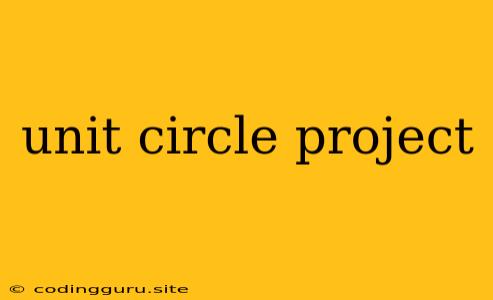Embark on a Journey of Understanding with a Unit Circle Project
The unit circle is a fundamental concept in trigonometry, offering a visual and interactive way to understand trigonometric functions. It's not just a circle; it's a gateway to a deeper understanding of angles, radians, sine, cosine, tangent, and their relationships. Creating a unit circle project can be an engaging and enlightening way to solidify your grasp on these concepts.
Why is a Unit Circle Project so Valuable?
- Visual Representation: The unit circle provides a visual framework to understand the values of trigonometric functions for different angles.
- Interactivity: A project allows you to create an interactive tool, whether digital or physical, that you can manipulate and explore.
- Application: The unit circle is not just a theoretical concept; it finds its application in various fields, including physics, engineering, and computer graphics.
Ideas for Unit Circle Projects
Here are some project ideas you can explore, each offering a unique approach to learning:
1. Interactive Unit Circle Tool
Project Description: Develop a digital or physical tool that allows you to input an angle and visually see its corresponding coordinates on the unit circle. You can enhance the tool with features like:
- Dynamic Angle Input: Allow users to input an angle, and watch the corresponding point on the circle move.
- Trigonometric Function Output: Display the values of sine, cosine, and tangent for the chosen angle.
- Angle Conversion: Allow users to convert between degrees and radians.
Example: You could use a programming language like JavaScript or Python to create an interactive web application, or use a physical tool like a protractor and a cardboard circle.
2. Unit Circle Art Project
Project Description: Create visual art pieces inspired by the unit circle. You can:
- Draw Geometric Patterns: Explore the patterns created by plotting points on the circle corresponding to different angles.
- Create Abstract Art: Use color and texture to represent the changing values of trigonometric functions.
- Explore the Relationship Between Angles and Coordinates: Design a piece that visually highlights the relationship between the angle and its corresponding x and y coordinates on the circle.
Example: You could create a series of colorful drawings depicting the unit circle with different angles highlighted.
3. Unit Circle Game
Project Description: Design a game that incorporates the unit circle concepts to reinforce learning. Here are some ideas:
- Angle Matching Game: Present two angles, and the player needs to determine if they are equivalent or not.
- Coordinate Guessing Game: Display an angle on the unit circle, and the player needs to guess the corresponding x and y coordinates.
- Trigonometric Function Quiz: Present a challenge where players need to answer questions about the values of sine, cosine, and tangent for different angles.
Example: You could create a simple web-based game using HTML, CSS, and JavaScript.
4. Unit Circle Presentation
Project Description: Create a presentation that explains the concept of the unit circle and its application. You can include:
- Visual Aid: Use diagrams, animations, and illustrations to make the presentation more engaging.
- Interactive Elements: Incorporate quizzes, interactive polls, or simulations to keep the audience involved.
- Real-World Applications: Highlight how the unit circle is used in different fields, such as physics, engineering, and architecture.
Example: You could create a presentation using PowerPoint, Google Slides, or Prezi.
5. Unit Circle Research Project
Project Description: Explore the historical development of the unit circle or its applications in different areas. Here are some areas to consider:
- The History of Trigonometry: Research the origins of the unit circle and its use in ancient civilizations.
- Unit Circle in Physics: Investigate how the unit circle is used in physics concepts like wave motion and oscillations.
- Unit Circle in Computer Graphics: Learn how the unit circle is applied to create animations and 3D graphics.
Example: You could write a research paper or create a poster presentation on your findings.
Tips for a Successful Unit Circle Project
- Start with the Basics: Make sure you have a solid understanding of the unit circle concepts before you embark on your project.
- Choose a Project that Interests You: Select a project that aligns with your interests and strengths.
- Be Creative: Don't be afraid to experiment and explore different ideas.
- Seek Help When Needed: If you encounter difficulties, don't hesitate to ask for help from your teacher, classmates, or online resources.
Conclusion
A unit circle project can be a rewarding experience that helps you solidify your understanding of trigonometric functions. Whether you create an interactive tool, an art piece, a game, a presentation, or a research project, it's an opportunity to explore the beauty and power of mathematics in a practical way. The unit circle, in its simplicity, opens doors to a vast world of mathematical applications and deeper insights into the world around us.
